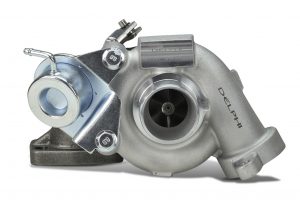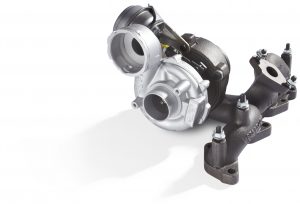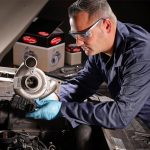As vehicles grow with age, turbocharger failure provides a real opportunity for factors and the wider aftermarket. Delphi explains why keeping ahead of turbo market trends is a good way to retain customer confidence and improve aftersales service.
The automotive industry works in cycles and its current love affair is with the turbocharger. This is understandably so, as forced induction is a vital mechanism for reducing emissions by enabling engine downsizing, a strategy implemented by the majority of vehicle manufacturers to reduce emissions while maintaining performance.
 Without turbochargers, petrol engines struggle to compete in terms of a performance and efficiency package, when compared to alternatives such as hybrids and full electric vehicles. While, for diesel applications, turbochargers have been almost a universal fit for several decades, providing a huge car parc of older vehicles that require cost-effective repairs.
Without turbochargers, petrol engines struggle to compete in terms of a performance and efficiency package, when compared to alternatives such as hybrids and full electric vehicles. While, for diesel applications, turbochargers have been almost a universal fit for several decades, providing a huge car parc of older vehicles that require cost-effective repairs.
The widespread use of turbochargers as the induction of choice is a huge opportunity for factors, from city cars and small passenger vehicles to sports and prestige cars. As the latest generation of vehicles with downsized, forced induction engines gets slightly older and filters into the service network, the aftermarket demand for replacement turbos will grow exponentially. For example, OE supplier Delphi expects the global turbocharger market to be worth $5.7bn by 2018, up more than 30% compared to 2015. The opportunity to drive factor business growth is there, but to successfully tap into the market, it is imperative that factors nurture their existing knowledge to inspire customer confidence and provide an optimised aftersales service.
Beyond looking at OE manufacturers, there has previously been very little choice with regards to aftermarket turbocharger replacement – Chinese-sourced turbos, from sites such as eBay, have provided a low cost but often unproven option where franchised dealer repair prices have proved to be prohibitive for owners. In these cases, a blown turbo can often lead to cars permanently leaving the road for spares or even scrappage. However, companies such as Delphi have understood the fact that demand is on the incline and could potentially boom, and have been steadily increasing the availability of their replacement OE-quality components.
 As has already been intimated, knowledge is power for a successful factor. To be able to offer the expertise and one-stop-shop capability for the latest generation of turbocharged vehicle provides customers with increased confidence and a potentially vital competitive advantage. So, with that in mind, Alex Visa, from Delphi, talks through the most common causes and effects of turbocharger failure.
As has already been intimated, knowledge is power for a successful factor. To be able to offer the expertise and one-stop-shop capability for the latest generation of turbocharged vehicle provides customers with increased confidence and a potentially vital competitive advantage. So, with that in mind, Alex Visa, from Delphi, talks through the most common causes and effects of turbocharger failure.
“Simplistically, there are four main causes for premature turbocharger failure: foreign object impact, oil starvation, oil contamination and overheating,” he explains. “There are steps that we can take to avoid premature failure and key pointers to look out for in identifying the cause to hopefully stop it happening again. Failure through foreign object impact, for example, can be caused by existing debris from a past turbo failure not being cleaned out of the induction system effectively and coming into contact with the turbine or compressor wheel. An old or incorrectly fitted air filter, damaged pipework or loose particles can all cause expensive damage to the turbo itself, or even the entire engine if shrapnel enters the combustion chamber.”
“A restricted oil feed, under-performing oil pump or degraded oil lines can also jeopardise turbocharger health through oil starvation,” advises Alex. “The tell-tale signs,” he says, “are excessive journal or thrust bearing wear (and possible seizure), overheating of main bearings and total main shaft failure. The same symptoms can be caused by leaking injectors or seals, split gaskets, failed O-rings or persistent poor maintenance, which can all lead to oil contamination.”
“The widespread use of turbochargers as the induction of choice is a huge opportunity for factors, from city cars and small passenger vehicles to sports and prestige cars.”
These examples of potential turbocharger faults and issues highlight how important it is for garages to fit top-quality units and to comprehensively understand how to diagnose a failure. This ensures garages are not burdened with another replacement at their own cost, due to the previously replaced component failing via an unresolved issue. The importance of top-quality units should be explained by a factor, using their industry knowledge and expertise to educate customers on the dangers and potential excess costs of using lower-quality, unproven components – compared to the likes of Delphi’s trusted, OE-quality units.
To conclude, turbocharger technology is advancing rapidly, offering both new wastegate designs that improve engine response and peak power output, and variable nozzle technology that optimises torque and overall driveability. Embracing these technologies and preparing for the rapidly growing number of turbocharged vehicles introduced into the service network by aligning expertise, quality component availability and market demand will ensure that factors and aftermarket businesses can evolve alongside the rest of the automotive industry.








